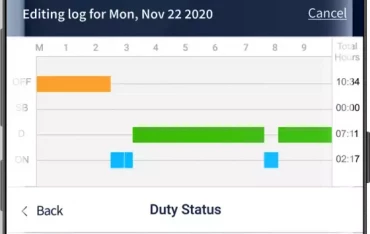From the ELD data: Drivers wade slowly into new HOS split options as 30-minute break violations dip

According to Overdrive‘s canvassing of a few electronic logging device providers, and with a focus on those that heavily serve the owner-operator and small-fleet world, ELD data shows many truckers dabbling with the new hours of service options available to them as of Sept. 29. Nearly all ELD makers interviewed in recent weeks reported a drop in detected 30-minute-break violations due to the more lenient regulations there.
By and large, however, there’s not been an overwhelming move by drivers to consistently use the new split-sleeper provisions.
Among some providers, however, there was an early spike in the use of the new split-sleeper-berth rules, which allow drivers more options to break up their on- and off-duty time as well as new opportunities to stop the countdown of the 14-hour window with the shorter break in a sleeper pair. “We’ve seen use of the split-sleeper berth options triple since implementation” of the updated HOS rule, said Ken Evans, CEO of Konexial, whose My20 ELD suite is geared toward owner-ops and small fleets. Evans compared data for the three weeks after Sept. 29 to the three weeks directly prior. “300% is a large increase,” he said. “[Drivers] have been leaning on it.”
That usage trend has remained steady.
There’s still definitely an ongoing learning curve, said Evans, and Konexial has been doing outreach to help its users learn and adapt to the new regs. “It will take a month or two before everybody’s aware of how it should work,” he said, and he foresees that translating to more widespread use. “But I also like to remind people that just because you can pause the clock doesn’t mean it’s good for your business. Nobody’s paying you while you’re paused.”
Other ELD providers also said their users are still trying to make sense of the new regulations relative to their operations, with drivers pinging support lines and email inboxes with questions, even if that hasn’t translated to a strong uptick real-world use examples as of yet.
“Any time there’s a rule change like this, it takes time for folks to get comfortable with it,” said Fred Fakkema, vice president of safety and compliance for ELD provider Zonar. “As drivers get used to the flexibility options, I think they’ll start using it to [the regulations’] full extent.”
KeepTruckin, whose ELD app holds a large presence among owner-operators, has seen a swell of questions from its users as to how to utilize the new regs, though the data points are mixed on use of the split-sleeper options so far. “Drivers want to take advantage of the rule,” said Abhishek Gupta, the company’s director of product, but right now, it appears KT users are still working to learn how to use the regs before putting them to use. So far, though, data does show a trend in increased use of the split-sleeper options since the Sept. 29 date.
Also, Gupta noted, the window of available data is limited — just more than a month since the Sept. 29 effective date. That doesn’t reflect the cyclical nature of drivers’ schedules, in which some weeks or months may lend themselves to greater use of the split-sleeper options than others.
Regarding the 30-minute break, nearly all ELD providers interviewed in recent weeks reported a sizable dip in detected violations for skipping the required break — now mandatory within the first eight cumulative hours of drive time rather than the first eight on-duty hours as before.
“That’s one piece of data that caught our eye,” said Avi Geller, CEO of Maven Machines, an ELD and telematics provider. “The number of violations for missing a 30-minute break is down 55% from what it was. That’s only based on one month of data, but it’s pretty dramatic.”
Geller said Maven is still analyzing the early data to get a feel for how its users are utilizing the new split options. “It’s clear that drivers are doing it,” he said, but they’re still analyzing the context of those uses — such as whether drivers are using the shorter break option to pause the 14-hour clock with a onetime use (followed by 10 hours off), or if most instances are employed as pairs, true 7/3 and 8/2 splits.
Anecdotally, Geller said, Maven users are still in the study phase, eyeing their regular schedules for ways to utilize the new split-cycle provisions. “As people get more comfortable with the reg and what it allows them to do, I think you’ll see more people taking advantage of the flexibility [the rule] provides.”
